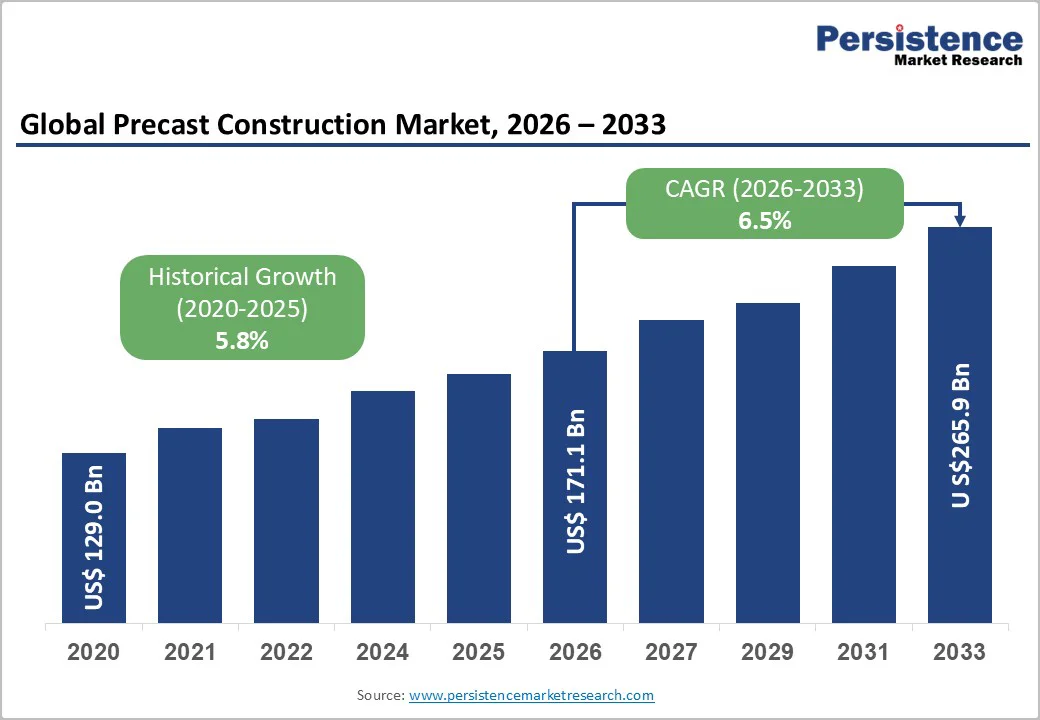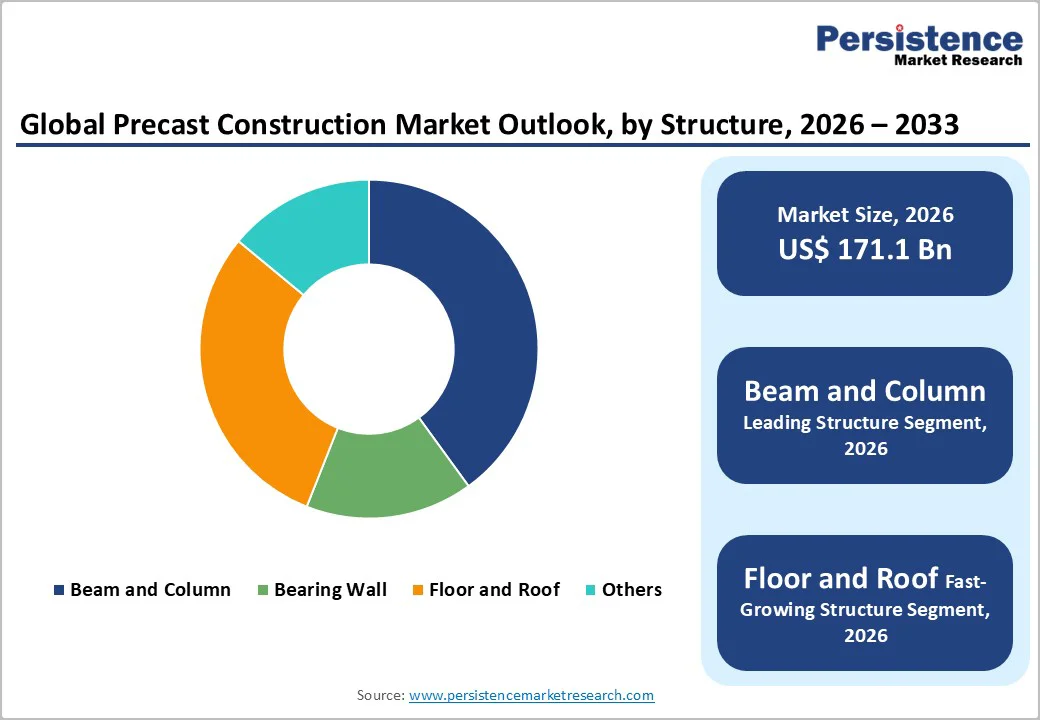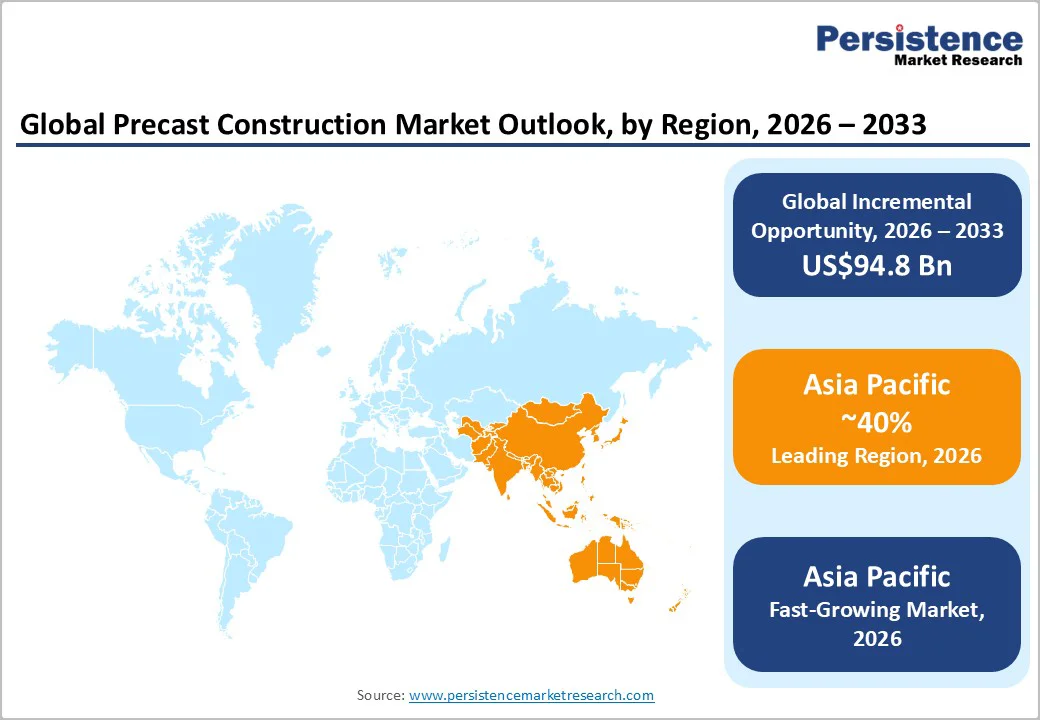ID: PMRREP13681| 197 Pages | 9 Dec 2025 | Format: PDF, Excel, PPT* | Industrial Automation

The global precast construction market size is likely to be valued at US$171.1 billion in 2026. It is expected to reach US$265.9 billion by 2033, growing at a CAGR of 6.5% from 2026 to 2033, driven by rising demand from efficiency gains in solar photovoltaic systems, with selective emitter designs reducing recombination losses and boosting output over standard cells.
Major drivers include the growing need for faster and more cost-effective construction methods, as precast components significantly reduce on-site labor and project timelines. Rising urbanization and infrastructure growth in emerging economies, coupled with the focus on sustainability and waste reduction, is driving demand for precast concrete systems.
| Key Insights | Details |
|---|---|
|
Precast Construction Market Size (2026E) |
US$171.1 Bn |
|
Market Value Forecast (2033F) |
US$265.9 Bn |
|
Projected Growth CAGR (2026-2033) |
6.5% |
|
Historical Market Growth (2020-2025) |
5.8% |

Urbanization and infrastructure spending are major drivers of market growth, driven by the need for faster, cost-efficient, and scalable building solutions. Rapid migration toward metropolitan areas has increased the need for multi-story residential buildings, mixed-use developments, and modern public facilities that can be delivered within shorter timelines. Precast systems enable faster assembly, reduced on-site labor, and consistent quality, making them ideal for dense urban zones where construction speed, safety, and space optimization are critical.
Infrastructure spending is accelerating as countries upgrade transportation networks, logistics hubs, and industrial corridors. Precast construction is becoming a preferred method for bridges, tunnels, flyovers, and commercial infrastructure due to its superior structural performance, durability, and lower lifetime maintenance requirements. The shift toward digital construction technologies, smart manufacturing, and factory-controlled production further enhances the reliability and scalability of precast components.
Setting up precast manufacturing facilities requires substantial investments in specialized machinery, molds, automated systems, and quality-control technologies. Developers must allocate resources for transportation logistics, material-handling equipment, and trained technical personnel, making the entry barrier higher than in traditional on-site construction. Smaller builders and regional contractors often hesitate to adopt precast methods due to upfront costs and the time required to achieve economies of scale.
Achieving consistent returns on precast infrastructure requires a stable pipeline of large projects, which may not always be guaranteed. In regions with fluctuating construction demand or fragmented regulatory environments, the high initial setup cost can deter investments in advanced precast plants. The transportation of heavy precast elements incurs additional fees, especially when projects are located far from manufacturing sites. These financial and logistical challenges can limit market penetration, delaying broader transitions toward industrialized construction.
Rapid population growth and rising urban migration create urgent demand for affordable, high-quality living spaces. Many developing regions are facing housing shortages and strained construction capacity, making traditional building methods too slow and labor-intensive to keep pace. Modular precast systems offer a scalable solution because they allow homes to be produced in controlled factory environments and installed quickly on-site with minimal disruption.
Emerging markets are expanding their industrial capabilities, enabling local production of precast components and modular units at competitive costs. Public authorities are increasingly promoting industrialized building methods to address housing deficits, encourage standardization, and reduce reliance on manual labor. The growth of smart cities, economic zones, and mass-housing programs further strengthens the business case for modular construction, as developers look for efficient solutions that can be replicated across multiple sites.
The beam and column segment is anticipated to lead, capturing around 42% of the total revenue share in 2026, driven by the structural framing segment for multi-story buildings. Its versatility allows use in commercial towers, mixed-use developments, and large residential complexes, providing reliable load-bearing performance and construction efficiency. For example, many large contractors in the U.S. and Europe increasingly adopt precast beams and columns for office parks and institutional buildings to speed up project delivery and improve structural consistency. The precision of factory-made beams and columns reduces on-site errors. It accelerates project timelines, making them essential in urban development projects where speed, safety, and structural integrity are critical.
The floor and roof segment represents the fastest-growing structure type, fueled by the rising demand for residential buildings with wide spans in affordable housing projects. Their lightweight, modular design supports quick assembly and reduced labor requirements, especially in urban and semi-urban regions. For example, several housing projects across Asia and the Middle East have adopted precast floor slabs and roof panels to shorten construction cycles and minimize site congestion in high-density areas. These systems support sustainability goals, enable wide structural spans, and integrate well with modern modular construction methods, driving rapid adoption.
Modular construction is expected to lead the market, capturing around 46% of the total revenue share in 2026. Valued for off-site assembly in permanent foundations. Its flexibility enables large-scale urban projects to achieve faster delivery while maintaining high-quality standards.
For example, several urban mid-rise residential and mixed-use projects in North America and Europe now rely on modular precast units to shorten project schedules and reduce labor dependencies. Modular systems reduce on-site labor, minimize construction waste, and offer design versatility for residential, commercial, and industrial applications, reinforcing their dominance in rapidly urbanizing regions.
Manufactured homes represent the fastest-growing construction type, targeting multi-family units in land-scarce areas. Their efficiency, ease of transport, and rapid installation make them ideal for high-density housing and affordable residential projects. For example, recent adoption of precision-engineered precast wall panels and roof systems in manufactured housing communities across Asia-Pacific and the U.S. has accelerated their growth due to improved durability and installation speed. Modern manufactured homes leverage advanced prefabrication technologies, including precision-controlled factory production, standardized components, and modular integration, which ensures high quality and minimizes on-site labor requirements.
The residential segment is likely to lead the precast construction market, capturing around 33% of total revenue in 2026, driven by strong demand for single-family housing, urban population growth, and the need for rapid-build solutions. Precast residential solutions provide durability, structural integrity, and consistent quality, enabling developers to meet housing needs efficiently while maintaining compliance with local and international building codes. Precast technologies are increasingly used in multi-family, gated, and mixed-use residential projects to reduce labor, shorten timelines, and cut costs.
The commercial segment is the fastest-growing end-user type, driven by growing urban infrastructure projects, the rapid expansion of offices and retail spaces, and the need for faster, cost-efficient construction. Precast systems accelerate construction timelines, lower labor costs, and allow large-scale modular integration, which is particularly valuable for high-rise commercial developments and urban expansion projects. The adoption of precast solutions in commercial projects also supports sustainability goals by reducing on-site construction waste, improving energy efficiency, and allowing for faster project delivery.

North America’s precast construction market is driven by rapid urbanization, large-scale infrastructure development, and increasing demand for durable and efficient building solutions. Precast technologies are widely adopted in residential, commercial, and industrial projects due to their ability to deliver high-quality, uniform structures with reduced on-site labor and faster construction timelines. Multi-story and mixed-use buildings increasingly use precast beams, columns, floors, and walls for safe, precise, and durable structural framing.
The commercial and infrastructure sector is also expanding, with precast systems used in offices, retail complexes, hospitals, educational institutions, and large-scale projects such as bridges and transit hubs. Technological advancements, including automated manufacturing, digital design tools, and sustainable materials, are enhancing efficiency and construction speed. These innovations help developers build durable, high-quality structures efficiently, making precast construction a reliable and scalable solution in North America.
Europe remains a significant market for the precast construction market, due to urban redevelopment, infrastructure modernization, and the growing demand for energy-efficient and sustainable buildings. Residential and commercial developers are adopting precast concrete solutions for multi-story housing, mixed-use complexes, and modular residential units due to their ability to reduce construction time, improve quality control, and minimize environmental impact. Government-backed EU green policies are driving demand for energy-efficient, recycled precast components.
Infrastructure projects, including bridges, tunnels, railways, and urban transit hubs, are increasingly using precast solutions to accelerate timelines and reduce on-site disruption. Technological advancements in automated production, BIM-enabled design, and lightweight, high-strength materials are enhancing project efficiency and sustainability. Cross-border collaborations and standardization of precast elements across the EU are streamlining construction practices and improving scalability.
Asia Pacific is likely to be the leading and fastest-growing region, accounting for 40% of the market share in 2026, driven by urbanization, infrastructure development, and the need for affordable, high-quality housing. Residential projects, including multi-family apartments and mixed-use developments, increasingly adopt precast beams, columns, floors, and wall panels to reduce construction time, lower labor requirements, and ensure consistent quality. Government initiatives promoting affordable housing, smart cities, and sustainable building practices are further accelerating the adoption of precast.
Infrastructure and commercial projects are also fueling growth, with precast solutions widely used in offices, retail complexes, educational institutions, hospitals, bridges, and transit hubs. Technological advancements, such as automated production, digital design tools, and high-strength lightweight materials, are enhancing efficiency and scalability. Investments in urban mobility, industrial zones, and disaster-resilient construction are further supporting the adoption of precast systems.

The global precast construction market exhibits a moderately fragmented structure, driven by a large number of regional and specialized firms operating alongside several major international players. Key leaders, including LafargeHolcim, CRH plc, CEMEX S.A.B. de C.V., Skanska AB, Balfour Beatty plc, and Tindall Corporation, dominate a significant share of global precast capacity.
These players compete through large-scale production capabilities, global distribution networks, and innovation in sustainable and modular construction technologies, enabling them to serve residential, commercial, and infrastructure segments across regions. Many pursue vertical integration, acquisitions, or strategic partnerships to expand their manufacturing footprint and broaden their product offerings.
The precast construction market is valued at US$171.1 billion in 2026 and expected to reach US$265.9 billion by 2033, reflecting robust growth.
Key drivers include rapid urbanization, infrastructure development, and the growing demand for faster, cost-efficient, and high-quality building solutions.
Residential is the leading segment in the market with about 33% share, driven by strong single-family housing demand and rapid-build durability benefits.
Asia Pacific leads the market with around 40% share, driven by rapid urbanization, large-scale housing programs, and strong manufacturing ecosystems across China, India, and Japan/ASEAN, and rising infrastructure-focused FDI that accelerates cost-efficient, policy-backed construction expansion.
Opportunities lie in the adoption of modular and off-site construction solutions, especially in emerging markets facing housing shortages and urban infrastructure expansion.
| Report Attribute | Details |
|---|---|
|
Historical Data/Actuals |
2020 - 2025 |
|
Forecast Period |
2026 - 2033 |
|
Market Analysis |
Value: US$ Bn |
|
Geographical Coverage |
|
|
Segmental Coverage |
|
|
Competitive Analysis |
|
|
Report Highlights |
|
By Structure Type
By Construction Type
By End-user
By Region
Delivery Timelines
For more information on this report and its delivery timelines please get in touch with our sales team.
About Author